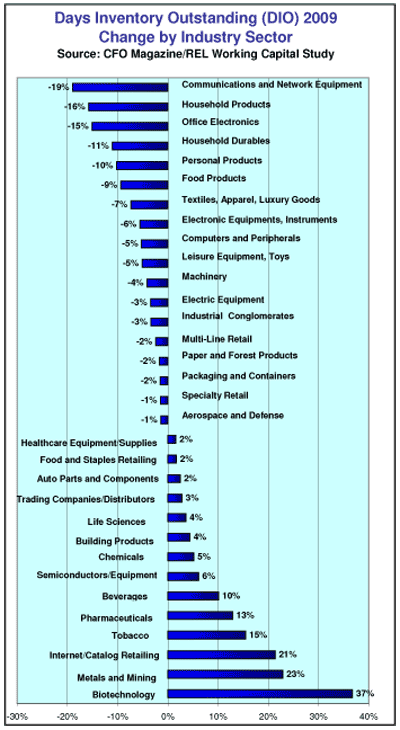I had been very much looking forward to the annual CFO maazine/REL working capital report for 2010, which was released last month. The report released in June analyzes 2009 numbers.
The report looks at overall Working Capital performance across a few dozen industry sectors and hundreds of companies. We focus on the inventory numbers, which they calculate using Days Inventory Outstanding (DIO), which is combined with payables and receivables data to come up with a total Working Capital number.
I was intrigued about what the inventory numbers would look like in the strange year that was 2009. The overall inventory to sales ratio spiked early on in the recession, as it always does, but then companies started cutting inventories like mad, reducing SKU counts, and anything they could do drive cash out of inventories.
Gilmore Says:
|
|
"One thing to keep in mind is that all of this is based on year end numbers, so it doesn't really tell you how well industries and companies were able to sense and respond to the drop in demand early on."
What do you say? |
|
Send us
your Feedback here |
|
The overall Working Capital numbers make it clear why there was an inventory reduction imperative. According to CFO, "2009 was one of the worst years ever for corporate working capital performance, and certainly the worst that CFO has reported since it began keeping track of working capital trends more than a decade ago."
Average days working capital (DWC) for 1,000 of the largest U.S. public companies jumped by 8.2% last year, the study found.
Working Capital is something of a strange term, as it sounds like a good thing. But it isn't as defined here. Working capital in this context means what could be cash that could be invested, paid out to shareholderrs, etc. is instead tied up in inventories and accounts receivable.
The study as always measures DIO as:
Inventory/[total revenue/365]
As such, it is sort of the reverse of inventory turns, in that a higher DIO, all things being equal, means poorer inventory management performance, while a lower number signals improvement.
The CFO report can be a bit confounding for supply chain watchers in that it often combines in the industry sectors very disparate companies, making the averages a little funny. As one example, in the Beverage sector, you have spirits Make Brown-Foreman with a 2009 DIO of 124 in the same grouping as Coca-Cola Bottling, with a DIO of 15.
Under Internet/Catalog retailing, travel web sites like Expedia, which has no inventory, are in the same mix with Amazon.com and the Home Shopping Network. Miners are mixed with steel producers, etc.
Oh well. Most sectors are not so confounded.
Below, is a list of the product-based sectors in the report, summarizing their DIO for the year and change from 2008 DIO levels:
- Aerospace and Defense: 48 (in 2009) from 49 in 2008
- Auto Parts and Components: 32 from 33
- Beverages: 25 from 23
- Biotech: 49 from 36
- Building Products: 41 from 40
- Chemicals: 53 from 50
- Communications and Networkinf Equipment: 23 from 29
- Computers and Peripherals: 20 from 21
- Containers and Packaging: 42 from 43
- Electrical Equipment (e.g., Emerson Electric, AO Smith): 40 from 42
- Electrical Equipment, Instruments and Components (e.g., Corning, Avnet): 39 from 41
- Food and Staples Retailing (grocery and drug stores): 30 from 29
- Food Manufacturing: 40 from 44
- Healthcare Equipment and Supplies (e.g., Becton Dickenson, Stryker): 45, flat from 2008
- Household Durables (which unfortunately includes home builders as well as Whirlpool and others): 68 from 77
- Household Products (consumer package goods): 38 from 45
- Industrial Conglomerates (e.g., 3M, GE): 45 from 47
- Internet/Catalog Retail: 16 from 13
- Leisure Equipment, Toys (e.g., Mattel, Eastman Kodak): 37 from 39
- Life Sciences (e.g., Bio-Rad, Thermo-Fisher Scientific): 40 from 39
- Machinery (e.g., Caterpillar, Illinois Tool Works): 54 from 57
- Metal and Mining: 70 from 57
- Multi-Line Retail (mass merchants and dept. stores): 56 from 58
- Office Electronics (a category of one – Xerox): 23 from 27
- Paper and Forest Products: 51 from 52
- Personal Products (e.g., Avon, Estee Lauder): 38 from 42
- Pharmaceuticals: 39 from 34
- Semiconductors and Equipment: 44 from 41
- Specialty Retail: Flat at 50
- Textiles, Apparel, Luxury Goods: 47 from 51
- Tobacco: 61 from 53
- Trading Companies and Distributors (e.g., Grainger, Kaman): 60 from 58
We also summarized the performance by sector from 2008 to 2009, from best to worst, as shown in the chart below (link to full size version of the chart below graphic. You can also find larger version on the web page link to this column below the Feedback button).

View Full Size Image (Click on it to Expand)
What does this all this mean? I am trying to figure that out myself. One thing to keep in mind is that all of this is based on year end numbers, so it doesn't really tell you how well industries and companies were able to sense and respond to the drop in demand early on - by year's end many had cut inventories ruthlessly.
The full CFO/REL report is available here:2010 working capital report.
We will do some additional analysis next week under the trends section of our On-Target newsletter. My quick reaction is that given the economic chaos, most companies and sectors performed pretty well, but would welcome your thoughts on this.
What's your reaction to the 2009 inventory numbers? Anything strike you? What further analysis needs done? Let us know your thoughts at the Feedback button below

Web Page/Printable Version of Column
|